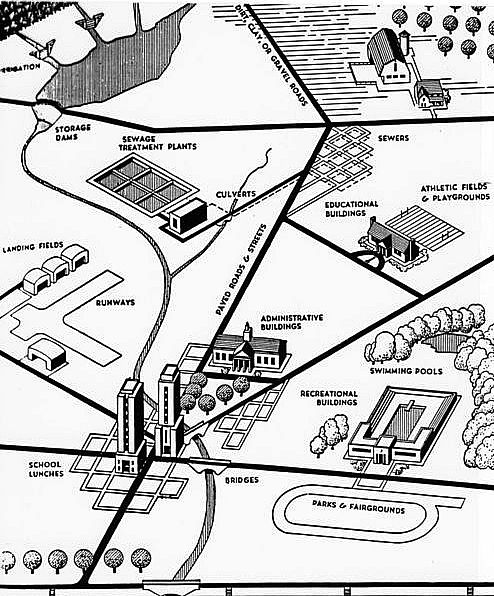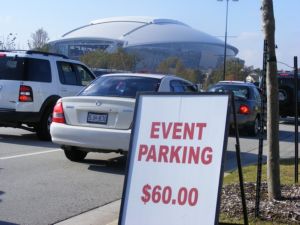 1940s WPA poster, showing various infrastructure projects that could benefit a community at the time || Unknown, WPA 1940s WPA poster, showing various infrastructure projects that could benefit a community at the time || Unknown, WPA |
Tom McNamara, Blueprint America
The Dallas Cowboys left town for a new stadium before the start of last year’s season. And the Dallas suburb of Irving, where the NFL team played from 1971 to 2008, is planning for life after football with a new transit-oriented development. At the same time, a new stadium just down the road has no transit access at all — except for a one-day, temporary rail line to be built for Super Bowl Sunday next year.
TRANSIT: ‘THE TALL T’ IN TEXAS
With a population around 200,000, Irving is a part of the North Texas Metroplex (nearly 7 million live there) — sprawl-land, U.S.A., to an outsider, but a part of the country that also has been building one of the most extensive mass-transit systems outside of the Northeast Corridor. That said, Texas was seen as the big loser when federal (stimulus) high-speed rail dollars were awarded earlier this year. It only received a $4 million grant for planning a project in the Dallas-Fort Worth area (with Irving in-between) as opposed to the hundreds of millions to even billions other states won.
When Texas Stadium is razed April 11, plans are already in place to redevelop the 80-acre site (with an additional 320-acres surrounding) located at the busy intersection of Texas highways 183 and 114, which about 150,000 cars pass through daily.
With new construction a least two years out, a city-contracted developer is looking for tenants in the meantime. And with the site’s proximity to the Dallas Area Rapid Transit light rail line to be installed next year, the area is primed for high density development — with plans for housing and condominium towers, a corporate or medical campus and an entertainment venue already in the works.
TEXAS TEA IS OIL, TOO
Older professional sports stadiums typically were built around highways and parking. Old Texas Stadium is a perfect example. But as the years went on, local mass-transit connected fans not wanting to pay big bucks for parking (or wanting to knock back a few drinks) to their teams. It happened in Irving and it happened in most sports-towns across the country. At the same time, almost all newly built stadiums now incorporate mass-transit, biking and walking (Target Field, the new Minnesota Twins stadium in Minneapolis, for example).
Cowboys owner Jerry Jones, however, built a $1.2 billion, 80,000-seat stadium 15 miles outside of Irving in the Dallas suburb of Arlington — the largest city in the country (population nearly 400,000) without a public transit system. The city recently tried a commuter bus system, but it met with little success. Arlington has even voted against tax increases several times in the last two decades that would have financed some form of public transit. Still, the city did increase the local sales-tax by a half cent in 2005 to pay for the new football stadium. On game day, as a result, area fans can spend hours in traffic and pay upwards of $60 for parking. And that’s just to get to the game — tickets to watch the game are even more expensive.
The lack of transit in the city can be seen in other ways, too. Rail connects Dallas to the east and Fort Worth to the west, but goes out of its way to avoid stopping in Arlington. And when the city hosts the Super Bowl next February, it will divert freight rail lines to set up a one-day rail stop — at a cost of $250,000 for a temporary public transit line, moving a projected 10,000 fans to the big game. The following day: Arlington will again be the largest city in the country without a public transit system.



